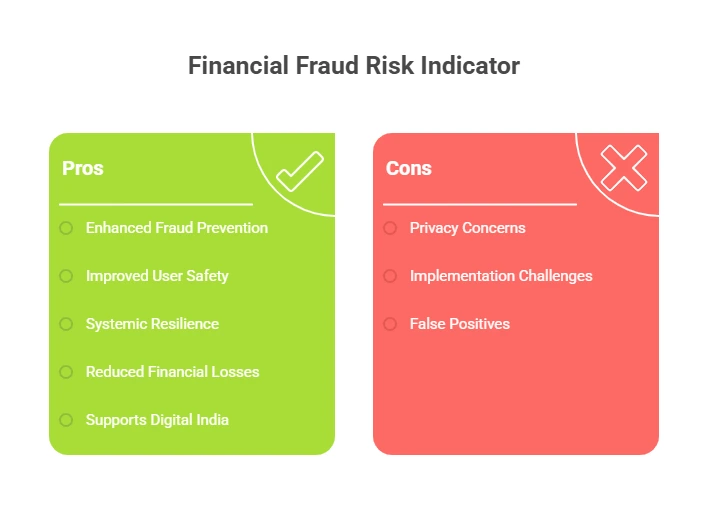The Department of Telecommunications (DoT) in India has taken a significant step toward curbing cybercrime in digital payments with the launch of the Financial Fraud Risk Indicator (FRI) on May 22, 2025. As cyber fraud cases continue to rise—evidenced by a 25% year-over-year increase in financial frauds reported by the Indian Cyber Crime Coordination Centre in 2024—this initiative aims to bolster the security of India’s digital financial ecosystem. In this article, we’ll explore the features, technology, and benefits of the FRI, highlighting its role in strengthening cybersecurity for banks, NBFCs, and UPI platforms like PhonePe, Paytm, and Google Pay.
- What is the Financial Fraud Risk Indicator (FRI)?
- Key Objectives of the FRI
- Features of the Financial Fraud Risk Indicator
- Risk Categorization
- Integration with Financial Platforms
- Mobile Number Revocation List (MNRL)
- Technology Behind the Financial Fraud Risk Indicator
- Machine Learning and Data Analytics
- Collaborative Data Sharing
- Real-Time Alerts and Actions
- Benefits of the Financial Fraud Risk Indicator
- Challenges and Future Considerations
- Conclusion
What is the Financial Fraud Risk Indicator (FRI)?
The Financial Fraud Risk Indicator (FRI) is a risk-based metric developed under the DoT’s Digital Intelligence Platform (DIP) to detect and mitigate financial fraud linked to mobile numbers. With the increasing sophistication of digital fraud, where fraudulent mobile numbers often remain active for just a few days, this tool provides an early warning system for stakeholders in the financial and telecom sectors.
Key Objectives of the FRI
- Combat Cybercrime: Address the growing threat of financial fraud in digital payments, particularly on UPI platforms.
- Enhance Collaboration: Enable banks, NBFCs, and UPI service providers to work together with the DoT to prevent fraud.
- Protect Users: Empower financial institutions to take proactive measures against suspected fraudulent mobile numbers.
Features of the Financial Fraud Risk Indicator
The FRI is designed to provide actionable insights to stakeholders by categorizing mobile numbers based on their risk levels. Here’s a closer look at its key features:
Risk Categorization
The FRI classifies mobile numbers into three distinct risk levels:
- Medium Risk: Indicates potential suspicious activity, prompting platforms to issue warnings or delay transactions.
- High Risk: Signals a higher likelihood of fraud, leading to stricter measures like mandatory user confirmations.
- Very High Risk: Triggers immediate action, such as blocking transactions outright, as implemented by PhonePe in its PhonePe Protect feature.
Integration with Financial Platforms
Major UPI players like PhonePe, Paytm, and Google Pay, which collectively handle over 90% of UPI transaction volume in India, have started integrating the FRI. For instance:
- PhonePe blocks transactions involving “Very High” risk numbers and displays alerts for “Medium” risk numbers.
- Paytm and Google Pay have introduced transaction delays and user confirmations for flagged numbers.
Mobile Number Revocation List (MNRL)
The DoT also circulates the Mobile Number Revocation List (MNRL), which includes numbers disconnected due to cybercrime involvement, failed verification, or excessive usage. This list helps financial institutions identify and block fraudulent numbers before they can be reused for malicious purposes.
Technology Behind the Financial Fraud Risk Indicator
The FRI leverages advanced technologies to analyze and flag suspicious mobile numbers, ensuring real-time fraud detection and prevention.
Machine Learning and Data Analytics
The FRI uses machine learning algorithms to analyze transaction patterns and detect anomalies. According to a 2023 IEEE study, AI-based fraud detection systems reduce false positives by 30% compared to traditional rule-based systems. The FRI processes data from multiple sources, including:
- National Cybercrime Reporting Portal (NCRP): Provides data on reported cyber fraud cases.
- DoT’s Chakshu Platform: Tracks suspicious telecom activities.
- Financial Institutions: Shares intelligence on fraudulent transactions.
By analyzing historical and real-time data, the FRI identifies patterns indicative of fraud, such as unusual spending behaviour or rapid account activity.
Collaborative Data Sharing
The FRI operates on a collaborative framework, integrating inputs from telecom operators, financial institutions, and government platforms. This multi-dimensional approach ensures a comprehensive risk assessment, making it harder for fraudsters to evade detection.
Real-Time Alerts and Actions
The system is designed to deliver real-time alerts to stakeholders. For example, if a mobile number is flagged as “High Risk,” UPI platforms can delay the transaction and prompt the user for additional verification, reducing the likelihood of fraud.
Benefits of the Financial Fraud Risk Indicator
The launch of the FRI by the DoT brings several benefits to India’s digital financial ecosystem, aligning with the goals of the Digital India initiative. Here are the key advantages:
1. Enhanced Fraud Prevention
The FRI empowers banks and UPI platforms to take proactive measures against financial fraud. By categorizing mobile numbers based on risk, the tool ensures that suspicious activities are flagged before they result in financial losses.
2. Improved User Safety
With features like transaction blocking and user alerts, the FRI protects millions of users from falling prey to cyber fraud. This is particularly crucial for UPI users, as UPI remains the most preferred payment method in India, processing billions of transactions monthly.
3. Systemic Resilience
The integration of FRI into customer-facing systems is expected to become an industry standard, bringing systemic resilience to India’s digital financial ecosystem. Collaborative action between telecom and financial sectors ensures a unified approach to tackling cybercrime.
4. Reduced Financial Losses
By enabling early detection of fraudulent mobile numbers, the FRI helps financial institutions minimize losses due to cyber fraud. PhonePe’s initial data shows high predictability of flagged numbers being involved in fraud, validating the tool’s efficacy.
5. Support for Digital India Goals
The FRI aligns with India’s vision of a secure digital economy under the Digital India initiative. By fostering a safer environment for digital payments, the DoT is encouraging greater adoption of digital financial services across the country.

Challenges and Future Considerations
While the FRI is a promising tool, its implementation raises some concerns that need to be addressed:
- Data Privacy: The system requires access to vast amounts of user data, sparking debates on privacy, as highlighted in a 2024 Supreme Court hearing on balancing cybersecurity with data protection rights.
- Bias in AI Models: Historical fraud data may contain biases, potentially leading to unfair outcomes, such as disproportionately flagging transactions from specific demographics.
- Scalability: As digital transactions continue to grow, the FRI must scale to handle increasing volumes without compromising accuracy or speed.
Conclusion
The launch of the Financial Fraud Risk Indicator by the DoT marks a significant milestone in India’s fight against cybercrime in digital payments. By leveraging advanced machine learning, real-time analytics, and collaborative data sharing, the FRI equips banks, NBFCs, and UPI platforms with the tools they need to detect and prevent financial fraud. With benefits like enhanced fraud prevention, improved user safety, and systemic resilience, this initiative is set to strengthen India’s digital financial ecosystem. However, addressing challenges like data privacy and AI bias will be crucial to ensuring its long-term success. As the FRI becomes an industry standard, it paves the way for a safer and more secure digital India.
Was this review helpful?
For more news about upcoming smartphones and popular products, and recommendations follow us on Facebook, Instagram, and Twitter.
Some of the links on our website are affiliate links. This means that if you click on these links and make a purchase, we may earn a small commission at no additional cost to you. These commissions help us maintain and improve our website, enabling us to keep delivering valuable content to you.




